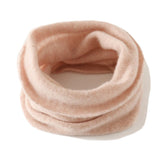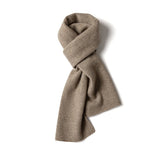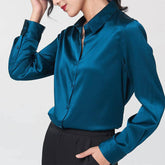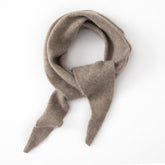What is Mulberry Silk? | Made From, Benefits, and Quality Insights
Mulberry silk is a premium type of silk produced by the Bombyx mori silkworms, which feed exclusively on mulberry tree leaves. This specialized diet gives the silk its exceptional softness, smooth texture, and uniform quality.
Accounting for about 90% of the world’s silk production, mulberry silk is highly valued for its strength, durability, and luxurious feel, making it a top choice for high-end garments and textiles.
The history of silk dates back thousands of years to ancient China. Legend says Empress Si Ling Chi discovered sericulture (aka, silk farming, the practice of breeding silkworms to produce raw silk) after a cocoon fell into her tea as she sat under a mulberry tree!
Let Slipintosoft’s experts guide you through everything you need to know about mulberry silk and its properties. If you like the sound of this luxury silk, browse through our top-quality products!
Production of Mulberry Silk


What is mulberry silk’s production process? Here’s how mulberry silk is made, from breeding the silkworms to reeling the silk.
Silkworm Breeding
The breeding of the Bombyx mori species of silkworm is where mulberry silk production begins. Breeders focus on traits like silk filament length, strength, and color. Healthy, high-yielding silkworms are chosen to reproduce, making sure that each generation maintains or improves these desirable characteristics and creates the highest quality silk.
Harvesting Mulberry Leaves
Mulberry leaves are the primary food source for silkworms. The techniques and timing of leaf harvesting make a big difference to the health and productivity of silkworms. Leaves are usually harvested in the early morning or late afternoon when their moisture content is optimal.
The leaves are checked frequently to make sure they are healthy, tender, and free of pests and diseases. The right timing and method of harvesting help provide high-quality nutrition to the silkworms, leading to the production of strong and fine silk threads.
Cocoon Formation
Silkworm larvae create cocoons from long silk fibers during their transformation into moths. This process, known as cocoon formation, takes around 5 to 6 weeks. The larvae secrete fibroin, a protein that hardens when it’s exposed to air, forming a continuous silk thread around themselves.
Each cocoon consists of a single, unbroken filament that can measure up to 1,500 meters! The conditions directly influence the quality and texture of the final silk product during this stage of development.
Silk Reeling Process
The silk reeling process involves harvesting and unraveling the cocoons to extract the silk fibers. Traditionally, this is done by boiling the cocoons with the silkworm inside, which softens the sericin, a natural glue holding the fibers together. This step enables the silk thread to be easily unwound.
An alternative method, producing “peace silk” or Ahimsa silk, allows the moth to emerge naturally from the cocoon before it’s boiled, so no harm comes to the insect. This method, while it’s more humane, results in shorter fibers and a slightly different texture of silk.
Production Statistics
| Cocoons Needed for 1 lb (0.45 kg) of Silk | 2,500 |
| Annual Global Production of Silk | ≈ 180,000 to 200,000 tons |
| Largest Silk Providers in the World | China (80%), India (18%) |
Characteristics of Mulberry Silk
Mulberry silk is renowned for its superior quality and unique characteristics. It’s prized for its strength, durability, and lustrous appearance, making it a popular choice for luxury bedding, clothing, and accessories.
Texture and Feel
Mulberry silk is luxuriously soft and smooth, often compared to the feel of cashmere or fine cotton. The superior quality of this silk comes from its long fibers, which create a fabric that drapes beautifully and feels exquisite against the skin.
Its natural smoothness helps reduce friction, making it gentle on hair and skin, which is why silk pillowcases and sleepwear are so popular.
Strength and Durability
With proper care, mulberry silk is highly durable and can last for many years. The long fibers of mulberry silk contribute to its strength, making it one of the most robust natural fibers available. Despite its delicate feel, it can withstand regular use and washing – so long as you handle it gently and clean it using mild detergents.
Color and Luster
Mulberry silk naturally has a beautiful sheen that adds an elegant touch to any garment or fabric. Its natural luster is a result of the silk fibers’ triangular structure, which reflects light at various angles. Also, mulberry silk holds dyes exceptionally well, giving you rich, vibrant colors that don’t easily fade over time.
Hypoallergenic Properties
Mulberry silk is resistant to dust mites, mold, and other common allergens, making it an excellent choice for those with sensitive skin or allergies. Its hypoallergenic properties are due to its natural protein structure, which repels many environmental allergens. This makes mulberry silk bedding and sleepwear even more coveted.
Other Properties
Mulberry silk is breathable and temperature-regulating, making it comfortable to use year-round. No need to change pillowcases or bedding every few months!
It also contains sericin, an antiaging protein, which helps retain moisture in the skin and hair. This unique property reduces hair tangles, frizz, and bedhead, and minimizes sleep wrinkles, promoting a healthier appearance.
Mulberry Silk Benefits
Skin and Hair Benefits
Mulberry silk has great benefits for both skin and hair. Its antiaging and anti-wrinkle properties stem from the silk’s ability to keep skin and strands hydrated, reducing the appearance of fine lines and keeping hair flexible.
The smoothness of mulberry silk is also great for reducing friction, which can prevent hair breakage and split ends. Moreover, sleeping on mulberry silk pillowcases can lead to healthier, smoother hair and reduce the risk of morning frizz.
Comfort and Breathability
One of the standout features of mulberry silk is its comfort and breathability. This natural fabric is cool in summer and warm in winter, making it suitable for all climates and all seasons. Its ability to regulate temperature is due to the silk’s natural protein structure, which allows for excellent airflow. It can also wick away moisture, helping to keep you dry and comfortable.
Environmental Impact
Mulberry silk production is environmentally friendly. The process of creating mulberry silk doesn’t involve synthetic dyes or harmful chemicals, making it a safer choice for the environment. Mulberry trees also absorb CO2 and support wildlife, contributing to ecological balance.
The production of mulberry silk needs less water and energy compared to synthetic fabrics, reducing its overall environmental footprint. Choosing mulberry silk supports sustainable and eco-friendly practices in the textile industry.
Uses of Mulberry Silk
Fashion and Apparel
Mulberry silk is highly valued in the fashion industry for its luxurious feel and elegant appearance. It’s often used in the creation of high-end clothing, including dresses, blouses, and suits, due to its softness, sheen, and drape.
This fabric is also popular for making accessories like scarves, ties, and shawls, which add a touch of sophistication to any outfit. Designers favor mulberry silk for its ability to hold vibrant colors and intricate patterns, making it a staple in luxury fashion collections.
Bedding and Home Textiles
In the realm of home textiles, mulberry silk is known for its comfort and hypoallergenic properties. It’s typically used in premium bedding items like pillowcases, sheets, and duvet covers. These silk products offer a smooth, cool surface that’s gentle on the skin and hair.
Mulberry silk can also be used for decorative purposes, with throw pillows and other decorative items boosting the aesthetic appeal of living spaces while providing the same luxurious feel.
Slipintosoft offers the highest quality silk items, including natural silk sheets, silk comforters, silk sleepwear, and more!
Medical and Cosmetic Applications
Mulberry silk’s unique properties extend beyond fashion and home décor into the medical and cosmetic fields. In medicine, it’s used to make surgical sutures due to its biocompatibility and strength, which help promote healing and minimize tissue reaction.
The silk protein, sericin, is also used in cosmetic products for its moisturizing and antiaging benefits. Sericin is known to improve skin elasticity and hydration, making it a sought-after ingredient in skincare formulations.
Comparison with Other Types of Silk


Mulberry Silk vs. Wild Silk
Mulberry silk is known for its smooth, soft texture and glossy appearance. In contrast, wild silk tends to have a coarser texture and a more matte finish. Wild silk fibers are generally less uniform in diameter, leading to a slightly rougher feel and a more natural look.
In terms of color, mulberry silk is often white or off-white, while wild silk can have a variety of natural colors, including beige, brown, and green.
The production of mulberry silk involves the cultivation of silkworms that feed exclusively on mulberry leaves. This controlled diet results in a finer, more consistent fiber. On the other hand, wild silk comes from silkworms that feed on various types of leaves in their natural habitat.
The harvesting process for wild silk can be less predictable, often resulting in fibers that aren’t as uniform as those produced from mulberry silk. Wild silkworms are usually allowed to mature and emerge from their cocoons, making the fibers shorter and less refined.
Tussah Silk vs. Mulberry Silk
Mulberry silk is typically pure white or off-white, thanks to the controlled diet of the silkworms. Tussah (or tussar) silk, however, is known for its rich, golden hue. This natural color can vary from pale gold to deeper shades, adding a unique aesthetic appeal.
In terms of strength, mulberry silk is stronger due to its longer, more uniform fibers, while tussah silk, although durable, tends to be less strong and has a more textured feel. The smooth texture of mulberry silk also makes it less prone to pilling and more comfortable against the skin.
Tussah silk is more porous than mulberry silk, allowing it to be cooler and more breathable, which is beneficial in warmer climates. Mulberry silk, with its fine and uniform fibers, offers a softer, more luxurious feel and is often used for high-end fashion and bedding.
Mulberry Silk vs. Eri Silk
Eri silk, also known as peace silk, is unique because the silkworms are not killed in the production process. This type of silk is spun from the cocoons after the moths have emerged, resulting in shorter fibers.
Eri silk has a woolly texture and is heavier than mulberry silk. It’s also more durable and less lustrous, with a matte finish that’s different from the shiny appearance of mulberry silk.
Eri’s eco-friendly production method is one of its main advantages, making it a popular choice for environmentally conscious consumers. Mulberry silk, on the other hand, isn’t as sustainable but is prized for its luxurious feel and smooth texture.
Caring for Mulberry Silk
Washing and Drying
Mulberry silk needs gentle care to maintain its luxurious feel and durability. When washing it, use cold water and a mild, pH-neutral detergent. It’s best to hand-wash the silk, gently agitating it without scrubbing.
Avoid soaking it for more than a few minutes at a time. Rinse thoroughly to remove any soap residue. When it comes to drying, don’t wring out the fabric. Instead, lay the silk flat on a clean, dry towel, and roll it up to squeeze out excess water. Unroll and reshape the garment, then lay it flat on another dry towel to air dry, away from direct sunlight or heat sources.
Storing and Maintaining
Store silk items in a cool, dry place, away from direct sunlight to prevent fading. Use breathable fabric bags or pillowcases to protect the silk from dust and insects, because plastic bags can trap moisture and cause mildew.
Avoid hanging silk garments for long periods, as this can distort their shape. To maintain the fabric’s natural sheen and softness, regularly air out the silk and use a cool iron if needed, always pressing on the reverse side or through a pressing cloth.
Common Mistakes to Avoid
Don’t use harsh cleaning methods like bleach or strong detergents, which can damage the delicate silk fibers. Also, avoid machine washing and tumble drying, because the agitation and heat can ruin the silk’s texture.
Improper storage, like using plastic bags or exposing the silk to direct sunlight, can cause the fabric to deteriorate. Also, never wring out silk garments — this can weaken the fibers and lead to wrinkles that are hard to remove.
How to Identify Real Mulberry Silk
Excellent quality silk can be hard to come by. There are many fake products on the market, and it may be easy to get caught out! Here’s how to tell if you're buying real mulberry silk fabric or not.
Tips for Distinguishing Real Silk from Fake
Texture and Feel Tests
Real mulberry silk has a smooth, soft texture that feels luxurious against the skin. When you rub it, it produces a subtle warmth due to its natural protein structure. Fake silk, often made from polyester, feels cold and slippery. To perform a texture test, crumple the fabric in your hand; real silk will wrinkle easily and regain its shape quickly, but fake silk often remains creased.
Burn Test for Fiber Identification
Carefully take a small sample of the fabric and burn it. Real silk burns slowly, smells like burning hair, and leaves behind a brittle, black ash. Fake silk, especially those made from synthetic fibers, burns quickly, smells like burning plastic, and leaves a hard bead-like residue. Perform this test safely and in a controlled environment.
Characteristics of High-Quality Silk Fabric
Visual and Tactile Indicators
High-quality mulberry silk has a natural sheen that changes color slightly under different lighting conditions. It feels exceptionally smooth and free from irregularities. The weave should be tight and uniform, without any loose threads or pulls.
Quality Markers
When examining silk fabric, look for evenness in color and texture. High-quality silk is dyed evenly, without any streaks or spots. Another marker is the thread count; authentic mulberry silk has a high thread count, contributing to its strength and durability. It also often has a weighty feel, reflecting its density and the use of more silk threads per inch.
Shopping for Authentic Mulberry Silk Products
Reputable Sources
To buy genuine mulberry silk, shop from well-known retailers and brands that specialize in silk products. Look for reviews and testimonials from previous customers to gauge the reliability of the source. Stores that are members of the International Silk Association or similar bodies are more likely to sell authentic products.
What to Look for on Labels
Examine the labels and product descriptions carefully. Authentic mulberry silk should be labeled as 100% mulberry silk or Grade 6A, the highest quality of silk available. Be wary of terms like “silk blend” or “satin silk”, which indicate that the product is not pure silk. Also, check for care instructions; real silk usually requires gentle hand-washing or dry cleaning.
FAQs on What is Mulberry Silk
Is Mulberry Silk Eco-Friendly?
Absolutely! Mulberry silk is considered eco-friendly due to its natural production process. Mulberry trees, which provide the leaves that silkworms feed on, need minimal pesticides and fertilizers. Also, the silk production process has a low carbon footprint compared to synthetic fabrics.
Moreover, the waste produced from silk manufacturing is biodegradable, and the silk itself can decompose naturally, making it a sustainable choice. Mulberry silk production even uses less water and energy than other textiles.
How long does Mulberry Silk Last?
Mulberry silk can last many years with proper care. This type of silk is made from long fibers, which contribute to its strength and longevity. When cared for correctly, mulberry silk can maintain its luster and quality for a long time.
Can people with allergies use Mulberry Silk?
Yes, people with allergies can use mulberry silk. This fabric is naturally hypoallergenic and resistant to common allergens such as dust mites, mold, and mildew. Its smooth texture also reduces friction, which can be beneficial for those with skin conditions like eczema.
Back to Top: What is Mulberry Silk? | Made From, Benefits, and Quality Insights










